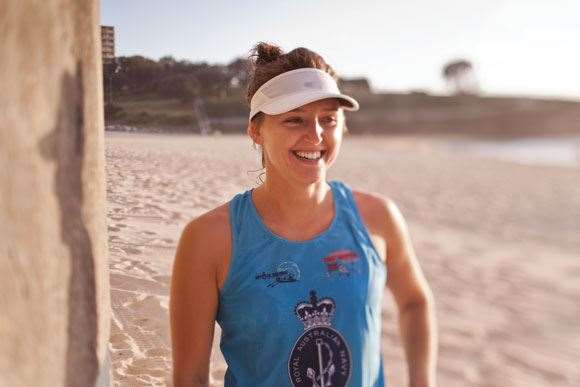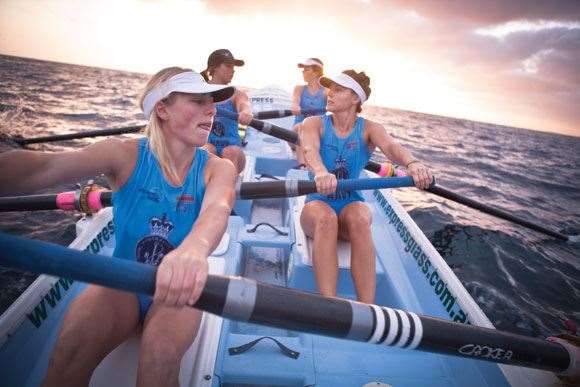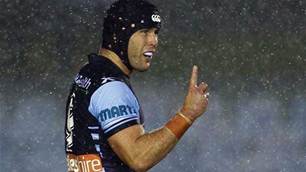Find out what it takes to do it for the girls in the Navy Australian Surf Rowers League.
 Photos By,Shelby Hayden Craig
Photos By,Shelby Hayden CraigFind out what it takes to do it for the girls in the Navy Australian Surf Rowers League on a stage so-long regarded the domain of the meathead beach alpha male.
Why would a young all-women’s crew take on a sport that’s so rough-and-tumble, many so-called tough blokes pass it up? There are only five young women in the country who are qualified to answer: the only female “sweep” on an all-female under-23s crew, Beck Hamilton, Grace Chapman, Kristen Raper, Katie Eynon and Olivia Toldi, who row in the Under-23s for Coogee SLSC in Sydney. We pulled Toldi, one of the “engine room” rowers, aside during an early (really early) training run to find out what it takes to do it for the girls in the Navy Australian Surf Rowers League on a stage so-long regarded the domain of the meathead beach alpha male.
GIRL POWER
“We’re an under-23s crew, so we’re not really unusual in that sense, but because we have Beck Hamilton on board for us, we’re the only crew with a female sweep. All the other all-girl crews we row against have male sweeps. There’s about 30 under-23s girls crews across Australia.”
COOGEE-MOOKS
“Our team used to be made up of girls who rowed together down in Mollymook on the NSW south coast. We all gradually migrated up to Sydney for uni and then got back together again. One day Beck said to us, ‘I’ll take you girls!’ She’d only been sweeping for a couple of years. Then things just kind’ve fell into place. Over the years we’ve had more and more Mollymook girls come up. These days we have Katie and Kristen from the north side of Sydney, but Grace and I are both from Mollymook. We used to joke about being the ‘Coogee-mooks’. We can’t really do that anymore because we have our precious north-side girls ... Nah, it’s all good! We love them. Kristen makes a massive effort. She drives from Avalon to Coogee every training morning. She’ll do that three times a week ... She makes such a commitment.”
JOB DESCRIPTION
“Beck stands at the back. She steers, guides and coaches. Grace is the one sitting in front of her: she’s the stroke; the timekeeper. In every race you need to keep a good pace and stroke-rate, and this needs to vary or be maintained at certain times. Grace is like the metronome of the boat; she just keeps ticking over.
“I’m second stroke. I’m there for strength, pretty much – to pull on the oar. Behind me is the second bow – that’s Kristen. We’re the engine room. We work together. We sit right in the middle part of the boat where you get the best pull from your oars.
“Katie is up the front. When we’re powering through the water, especially through waves, the boat bounces a lot. As soon as you hit the water on the down, the water puts a massive ‘brake’ on the boat. Katie’s job is to keep that nose down. If we can keep it from bouncing in time, we can get the boat to really cut through. Because she’s up high, it’s hard for her to put in a lot of effort; her oar is a lot more angled than ours.
“When we head out, smashing through waves, the two girls behind me in the bow are always up in the air; they have to go up and make sure they don’t fall out! If everyone is doing their job, nothing ever goes wrong. But as soon as someone starts worrying about someone else not putting in, or someone starts slacking off, it can all come undone. Beck always says, ‘Pull the weight off your mate’s back.’ If you don’t like the people you row with, you’re not going to row very well, because you’re not going to want to help them out.”
 Photos By Shelby Hayden Craig
Photos By Shelby Hayden CraigSWEEPING UP
“It’s always the sweep’s job to make sure we’re working together and rowing together. Beck’s responsible for the race plan. Because we can’t see where we’re going, she’s our eyes and ears during a race or training session. It doesn’t work without a sweep. A couple of times she’s been thrown out. You don’t have the single person guiding you when something like that happens; it takes a lot for one person to stand up out of a four-person crew and say, ‘Now, I’m telling you what to do.’ Technique is such a big thing, too. Beck is always telling us, ‘Elbows up! Shoulders back!’ Everything we do is technique-based.”
RACE-DAY ROUTINE
“Usually it’s a very early start. You have to get your gear off the trailer, then get your equipment off the boat, and then get your boat down onto the beach. Then you have to get your tents set up, etc.
“Each crew is different and has its own areas it likes to focus on before a race. We’ll go out and get the lungs going and get the heart-rate up with a nice big warm-up; a nice long row. Then, if we feel we need to, we’ll do a couple of practice starts, and maybe a turn, say, a couple of hundred metres out and back, just to make sure we know what the surf is doing.
“The gate cans are the first marker – they’re at half-way. They’re always out past the break; if the break’s big, they’re going to be further out. Then you have the buoy cans, which you turn at. For our warm-up, we’ll usually go out to the buoys, then come back in and do a little bit of work at moderate effort, usually for ten or 15 minutes. We’ll build it up, go for a bit of effort; hard to flat-out for one bit and then bring it back down, then go up again just to make sure we’re fully clicked on and ready to go for the day. As soon as the day starts, it just keeps ticking over and if you’re not ready, it kind of just gets away from you.”
 Photos By, Shelby Hayden Craig
Photos By, Shelby Hayden CraigSTAYING ALIVE
“Sometimes surf rowing race days are three-round point score events where the officials allow the six highest scoring boats to progress to the next round. If it’s a knockout event, you just have to keep placing in the top three or top four. At some knockout events there’s a repecharge round; if your crew has been falling behind, it gives you one more chance to make it to the final.
“Usually you’ll have a minimum of three races. If you’re in the repechage you’ll have four, and you might be good enough to reach the semis, then the final. You’re always hoping for six races, but don’t always get six.”
WINNERS ARE GRINNERS
“The overall aim is always gold at the Aussie championships. If any rower tells you otherwise, they’re lying. The Navy runs huge carnivals through the year where teams accumulate points. There’s other ones where you race for prizemoney and medals ‒ but no one remembers those. People only remember who won Aussie gold. In most surf clubs, if you finish on top of the podium, you get your photo on the club wall.”
NO SLACKERS
“In a race, it’s hard to just keep it going; to keep your rowing momentum up. A lot of the time, especially in our division – I’m a woman, I can say this – girls can put that ‘pathetic’ face on when it’s heavy or there’s a big wave. You can see it – the girls get very tired. In those times, you just have to row like the blokes. And that’s what it comes down to. The girls who have more grunt, who can push through waves, are the ones who are back at the beach first. That’s what all the training and the long hours are for. You want to put in the effort.”
SITTING PRETTY
“Rowing looks like it’s all upper-body, but in reality, 90 per cent of the work is in the legs. Ten per cent is moving your arms; you just have to be able to hold the oar, just so you don’t let go. Rowing is like a seated squat. You’re just sitting there, always pushing. All the women ‘love’ the fact that when you start rowing you develop really nice man thighs ... It’s just one of the perks that come with the sport ... not very feminine bodies.”
JUST LIKE BAYWATCH
“Just to make sure we don’t get bored with our training program, Beck has put in a couple of sand runs. The last couple of weeks we’ve had two 40km bike rides, too. There was a bit of a study done a while ago, Beck was saying, that said rowers make good bike riders. It’s all about the legs, I suppose. Just building up your muscle and your strength and endurance in that area.”
LOP-SIDED
“A lot of surf rowers have back problems because we’re always on one side. When you’re doing normal, still-water rowing, you’re straight up and down. But because you’re rowing a surf boat, you have to lean in, and everyone gets this crooked back syndrome where you’re overdeveloped on one side. Physios hate you and chiropractors love you.”
 Photos By, Shelby Hayden Craig
Photos By, Shelby Hayden CraigWEIGHTING GAME
“We have three beach training sessions each week. This weekend we have a carnival, so we’ll just have two. We have a weights session each week as well.
“The main point of our weights training is to work towards our fitness goal. The focus of one training block might be our endurance muscles, in which case we’ll do light weights at high repetition. We might go three or four weeks working with really light weights and a lot of sets in a two-hour session. In our heavy weights sessions, which focus on strength, there’s a lot of leg work and a lot of back work using squats, benchpresses or lunges. There’s a lot
of seated rows and isolating our shoulder muscles, too.
“We also incorporate a circuit into our gym work; say, 15 reps at seven different ‘stations’. Then we’ll sit on the ‘erg’ rowing machine for five minutes, then go back and do it all again – three times all up. We might do some hill sprints afterwards, which gives us an excuse to get off the beach. It’s really broken up ‒ a lot of interval training.
“Apart from all that, we’ll have another separate 45-minute session on the erg. We might do, say, a pyramid of distance: 500m, 1000m, 1500m and then come back down. Or we’ll do two minutes on a hard setting, two minutes on a light setting, 10-15 times.”
ADDICTIVE
“I love surf rowing; it’s a bit addictive. Sometimes we get to carnivals, or it’s a really bad day, and nothing really works out; some days it just doesn’t happen. Some days our gear is broken, someone doesn’t turn up, or turned up too late, or the surf’s crap. And you wonder, ‘Why am I doing this again?’ And the next day you’re back in the boat ... and back on the beach!
“It’s almost a habit you develop. It’s a big community thing, too. I enjoy all the people I row with. There are a lot of people I’ve rowed with in the past who’ve said, ‘I don’t know how you still do it.’ But they didn’t have a good experience, they didn’t have friends to row with or they just didn’t put themselves into the club enough.”
ROWING FOR LIFE
“This is my last year in the under-23s division. I’m thinking about having a year off. After this, there’s no age divisions; it’s just open ladies from here for me. I might have a year off and see what it’s like having a life across summer; once you row, that’s it. I don’t do anything over summer except row. I looked at my calendar the other day and I saw only two weekends off between December and April.”
‒ James Smith
Related Articles

Training with the Cronulla Sharks' Michael Ennis

Training with the Cronulla Sharks' Michael Ennis













